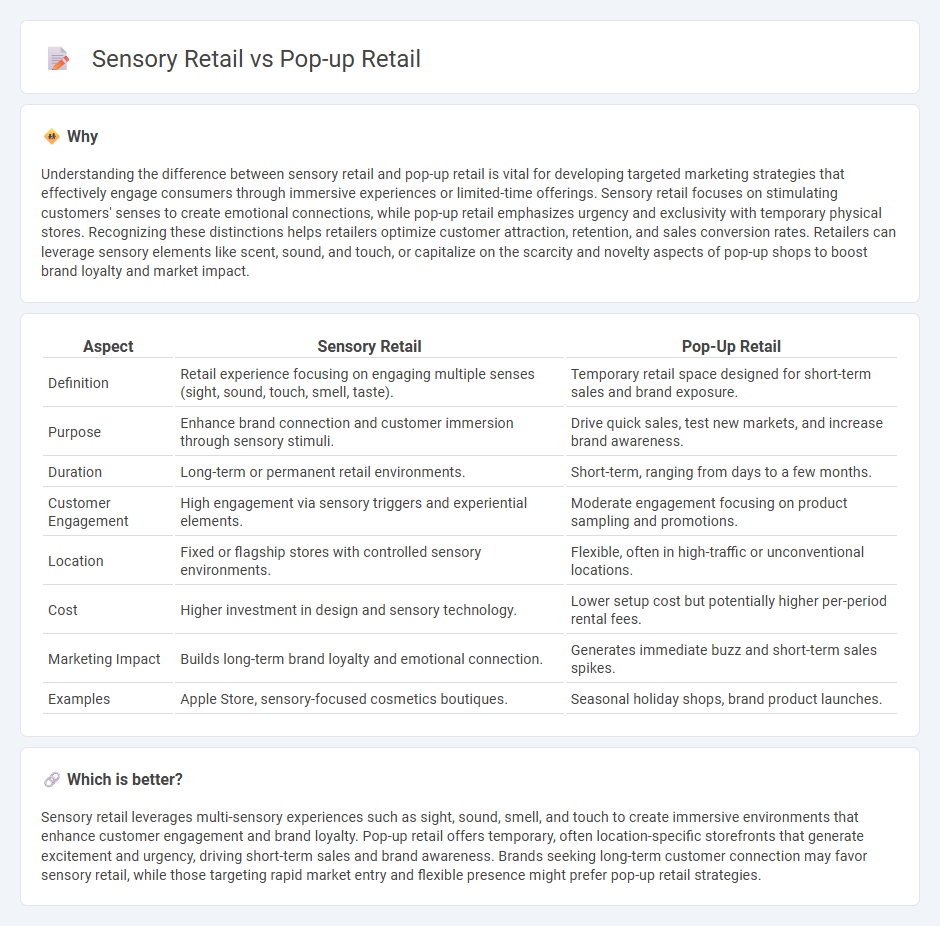
Sensory retail engages customers through immersive experiences involving sight, sound, touch, smell, and taste, enhancing brand connection and driving purchase decisions. Pop-up retail focuses on temporary, flexible storefronts that create buzz and exclusivity while testing new markets or products. Explore how combining sensory elements with pop-up strategies can revolutionize your retail approach.
Why it is important
Understanding the difference between sensory retail and pop-up retail is vital for developing targeted marketing strategies that effectively engage consumers through immersive experiences or limited-time offerings. Sensory retail focuses on stimulating customers' senses to create emotional connections, while pop-up retail emphasizes urgency and exclusivity with temporary physical stores. Recognizing these distinctions helps retailers optimize customer attraction, retention, and sales conversion rates. Retailers can leverage sensory elements like scent, sound, and touch, or capitalize on the scarcity and novelty aspects of pop-up shops to boost brand loyalty and market impact.
Comparison Table
| Aspect | Sensory Retail | Pop-Up Retail |
|---|---|---|
| Definition | Retail experience focusing on engaging multiple senses (sight, sound, touch, smell, taste). | Temporary retail space designed for short-term sales and brand exposure. |
| Purpose | Enhance brand connection and customer immersion through sensory stimuli. | Drive quick sales, test new markets, and increase brand awareness. |
| Duration | Long-term or permanent retail environments. | Short-term, ranging from days to a few months. |
| Customer Engagement | High engagement via sensory triggers and experiential elements. | Moderate engagement focusing on product sampling and promotions. |
| Location | Fixed or flagship stores with controlled sensory environments. | Flexible, often in high-traffic or unconventional locations. |
| Cost | Higher investment in design and sensory technology. | Lower setup cost but potentially higher per-period rental fees. |
| Marketing Impact | Builds long-term brand loyalty and emotional connection. | Generates immediate buzz and short-term sales spikes. |
| Examples | Apple Store, sensory-focused cosmetics boutiques. | Seasonal holiday shops, brand product launches. |
Which is better?
Sensory retail leverages multi-sensory experiences such as sight, sound, smell, and touch to create immersive environments that enhance customer engagement and brand loyalty. Pop-up retail offers temporary, often location-specific storefronts that generate excitement and urgency, driving short-term sales and brand awareness. Brands seeking long-term customer connection may favor sensory retail, while those targeting rapid market entry and flexible presence might prefer pop-up retail strategies.
Connection
Sensory retail enhances customer experience by engaging multiple senses such as sight, sound, smell, and touch, creating memorable interactions that boost brand loyalty. Pop-up retail leverages this sensory engagement by offering immersive, limited-time environments designed to attract foot traffic and stimulate impulse purchases. Both strategies focus on creating strong emotional connections through experiential marketing, increasing customer engagement and driving sales in competitive retail landscapes.
Key Terms
**Pop-up retail:**
Pop-up retail offers a temporary, flexible shopping experience designed to create buzz and drive immediate sales, often leveraging high foot traffic locations to maximize brand exposure. This retail strategy emphasizes urgency and exclusivity, providing unique product launches or limited-time offerings that attract curious consumers. Discover how pop-up retail can transform your brand presence and customer engagement today.
Temporary store
Pop-up retail leverages temporary stores to create exclusive shopping experiences that drive urgency and excitement, often maximizing foot traffic in high-visibility locations for a limited time. Sensory retail emphasizes engaging multiple senses through tactile displays, scents, and sounds to deepen customer connection and enhance brand perception within these ephemeral spaces. Explore how integrating sensory strategies into pop-up stores can amplify consumer engagement and boost sales outcomes.
Limited-time offer
Pop-up retail captures consumer attention by offering limited-time, exclusive products that create urgency and drive immediate sales. Sensory retail enhances this experience by engaging multiple senses--sight, sound, touch, and smell--to create memorable brand interactions that deepen customer emotional connection. Explore how combining limited-time offers with sensory elements can maximize impact and boost consumer engagement.
Source and External Links
What Is Pop-Up Retail? - StoreForce - Pop-up retail, also known as pop-up shops or temporary retail, involves opening short-term sales spaces in various locations to create unique customer experiences and generate excitement, with flexibility and temporary presence as key features.
What is a pop-up shop? Benefits, types, and how to start - Printify - A pop-up shop is a temporary retail space, physical or online, designed to attract new customers, generate buzz, and test markets without the long-term costs of permanent stores, often through immersive and limited-time experiences.
Pop-up retail - Wikipedia - Pop-up retail refers to temporary sales spaces used to build interest, test products or markets, and create engaging environments, often seasonal or event-driven, with a focus on marketing, flexibility, and cost-efficiency.
 dowidth.com
dowidth.com